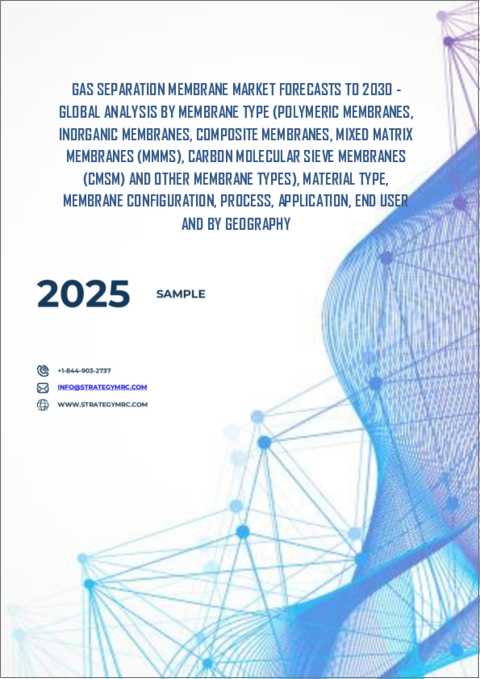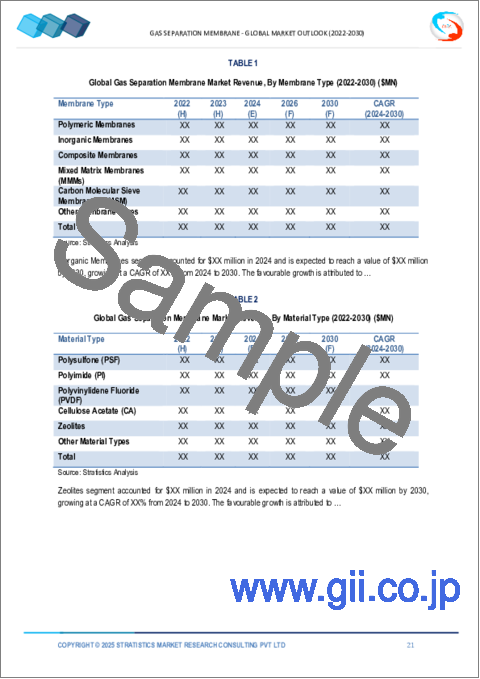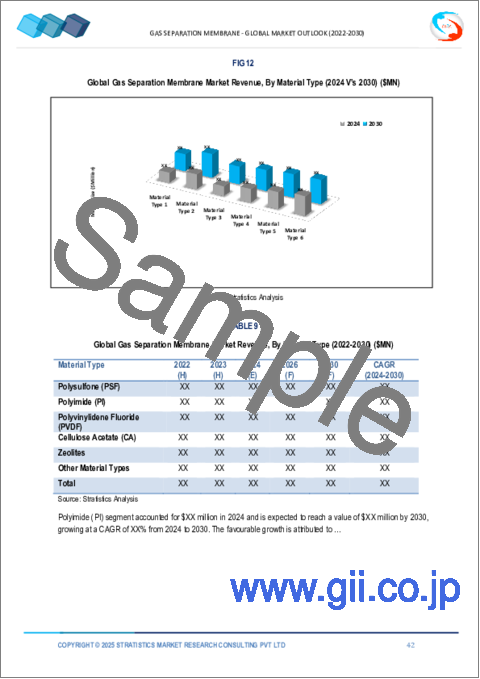|
|
市場調査レポート
商品コード
1625218
ガス分離膜市場の2030年までの予測: 膜タイプ別、材質別、膜構成別、プロセス別、用途別、エンドユーザー別、地域別の世界分析Gas Separation Membrane Market Forecasts to 2030 - Global Analysis By Membrane Type, Material Type, Membrane Configuration, Process, Application, End User and By Geography |
||||||
カスタマイズ可能
|
|||||||
| ガス分離膜市場の2030年までの予測: 膜タイプ別、材質別、膜構成別、プロセス別、用途別、エンドユーザー別、地域別の世界分析 |
|
出版日: 2025年01月01日
発行: Stratistics Market Research Consulting
ページ情報: 英文 200+ Pages
納期: 2~3営業日
|
全表示
- 概要
- 図表
- 目次
Stratistics MRCによると、ガス分離膜の世界市場は2024年に19億米ドルを占め、予測期間中にCAGR 7.0%で成長し、2030年には28億米ドルに達する見込みです。
ガス分離膜は、サイズ、溶解度、拡散性に基づいて混合物から異なるガスを選択的に分離するように設計された半透過性バリアです。これらの膜は、天然ガス精製、炭素回収、酸素濃縮など、様々な工業プロセスで使用されています。これらの膜に使用される材料は、ポリマーから無機物質まで多岐にわたり、それぞれが効率、選択性、耐久性の面で特定の利点を提供しています。ガス分離膜は、さまざまな用途でエネルギー効率を向上させ、環境への影響を減らすために不可欠です。
世界鉄鋼機関によると、2023年12月の中国の鉄鋼生産量は67.4トンです。一方、インドは世界第2位の粗鋼生産国に上り詰めました。同国は2022-23会計年度に602万トンを輸入する一方、672万トンの完成鋼を輸出しました。
天然ガス需要の増加
天然ガス需要の高まりが市場の成長を大きく後押ししています。天然ガスの生産が世界的に増加する中、ガスの精製と処理には効率的な分離技術が不可欠です。ガス分離膜はエネルギー効率の高いソリューションを提供し、エネルギー、石油化学、環境用途などの産業でコストを削減し、生産性を向上させます。この動向は、よりクリーンなエネルギー・ソリューションと分離効率の向上に対するニーズが強まるにつれて、今後も続くと予想されます。
膜のファウリングと劣化
膜のファウリングと劣化は市場に大きな悪影響を及ぼします。ダスト、オイル、生物学的物質などの汚染物質によるファウリングは、膜効率を低下させ、運転コストの上昇と頻繁なメンテナンスにつながります。化学物質への暴露や物理的摩耗による劣化は、膜の寿命を縮め、性能に影響を与え、交換コストを増加させます。これらの問題は、長期的な運転安定性を妨げ、システム効率を低下させ、様々な産業における膜技術の普及を制限します。
膜技術の進歩
膜技術の進歩は、効率と選択性を向上させることで市場を変革しています。材料の革新はガス透過性と分離性能を向上させています。ナノエンジニアリングやハイブリッド膜システムのような新しい技術は、寿命を延ばし、エネルギー消費を削減しています。これらの進歩は、天然ガス処理、石油化学、CO2回収などの産業において、よりクリーンで効率的なガス分離に対する需要の高まりに応える上で極めて重要です。
運転条件の影響を受けやすい
運転条件に対する敏感性は、様々な環境要因の下で膜の性能を制限することにより、市場に悪影響を与えます。温度、圧力、フィード組成の変動は、分離効率を著しく低下させ、一貫性のない結果をもたらす可能性があります。この感度は、性能を最適化するためにシステムの頻繁な調整やメンテナンスを必要とするため、運転コストを増加させます。その結果、特定の条件に依存することは、多様な用途における膜技術の汎用性と広範な使用を妨げることになります。
COVID-19の影響:
COVID-19の流行は、世界のサプライチェーンを混乱させ、製造プロセスを遅らせ、石油・ガス・石油化学などの主要産業からの需要減少を引き起こすことによって、市場に悪影響を与えました。さらに、操業停止期間中の産業活動や投資の減少が、高度なガス分離技術の採用を遅らせました。しかし、産業が回復するにつれて、エネルギー効率が高く持続可能な分離ソリューションに対する需要の増加により、市場は回復すると予想されます。
予測期間中、高分子膜セグメントが最大になる見込み
高分子膜セグメントは、予測期間中に最大の市場シェアを占めると予想されます。これらの膜は、天然ガス精製、CO2回収、窒素分離に広く使用されており、低エネルギー消費で効率的な性能を提供しています。ポリマー材料配合の進歩により選択性と耐久性が向上し、さまざまな産業用途でますます人気が高まっています。その汎用性により、高分子膜はガス分離技術における主要な選択肢となっています。
予測期間中、石油・ガス分野のCAGRが最も高くなる見込み
石油・ガス分野は、天然ガス精製、二酸化炭素除去、水素分離などのプロセスに不可欠な膜であるため、予測期間中のCAGRが最も高くなると予想されます。膜は、不純物の除去、ガス品質の改善、資源抽出の最適化のための効率的でコスト効率の高いソリューションを提供します。よりクリーンなエネルギーに対する世界の需要が高まる中、石油・ガスセクターにおいて、ガス分離膜は従来の分離技術に代わる持続可能でエネルギー効率の高い選択肢を提供しています。
最大のシェアを占める地域
北米地域は、天然ガス需要の増加、環境規制の厳格化により、予測期間中最大の市場シェアを占めると予測されます。石油・ガス、石油化学、エネルギーなどの主要産業が、CO2除去や天然ガス精製などの用途にガス分離膜の採用を促進しています。膜技術の革新は、持続可能なエネルギーへの多額の投資とともに、この地域での市場拡大をさらに後押ししています。
CAGRが最も高い地域:
アジア太平洋地域は、環境の持続可能性への関心の高まりと、よりクリーンなエネルギーソリューションの推進により、予測期間中に最も高い成長率を記録すると予想されます。同市場は、性能、耐久性、コスト効率の向上を提供する高分子膜や複合膜などの膜材料の進歩から恩恵を受けています。天然ガスの需要が増加し続け、環境規制が強化されるにつれて、この地域のガス分離膜市場は継続的な成長が見込まれています。
無料のカスタマイズサービス
本レポートをご購読のお客様には、以下の無料カスタマイズオプションのいずれかをご利用いただけます:
- 企業プロファイル
- 追加市場プレイヤーの包括的プロファイリング(3社まで)
- 主要企業のSWOT分析(3社まで)
- 地域セグメンテーション
- 顧客の関心に応じた主要国の市場推計・予測・CAGR(注:フィージビリティチェックによる)
- 競合ベンチマーキング
- 製品ポートフォリオ、地理的プレゼンス、戦略的提携に基づく主要企業のベンチマーキング
目次
第1章 エグゼクティブサマリー
第2章 序文
- 概要
- ステークホルダー
- 調査範囲
- 調査手法
- データマイニング
- データ分析
- データ検証
- 調査アプローチ
- 調査情報源
- 1次調査情報源
- 2次調査情報源
- 前提条件
第3章 市場動向分析
- 促進要因
- 抑制要因
- 機会
- 脅威
- 用途分析
- エンドユーザー分析
- 新興市場
- COVID-19の影響
第4章 ポーターのファイブフォース分析
- 供給企業の交渉力
- 買い手の交渉力
- 代替品の脅威
- 新規参入業者の脅威
- 競争企業間の敵対関係
第5章 世界のガス分離膜市場:膜タイプ別
- 高分子膜
- 無機膜
- 複合膜
- 混合マトリックス膜(MMM)
- 炭素分子ふるい膜(CMSM)
- その他の膜タイプ
第6章 世界のガス分離膜市場:材質別
- ポリスルホン(PSF)
- ポリイミド(PI)
- ポリフッ化ビニリデン(PVDF)
- セルロースアセテート(CA)
- ゼオライト
- その他の素材の種類
第7章 世界のガス分離膜市場:膜構成別
- フラットシート
- 中空糸
- スパイラル巻き
- 管状
第8章 世界のガス分離膜市場:プロセス別
- 浸透による分離
- 吸収による分離
- 吸着による分離
第9章 世界のガス分離膜市場:用途別
- 天然ガス処理
- バイオガス精製
- 酸素濃縮
- 炭素回収貯留(CCS)
- 水素回収と分離
- 空気分離
- その他の用途
第10章 世界のガス分離膜市場:エンドユーザー別
- 石油・ガス
- 化学・石油化学製品
- ヘルスケアと医療
- 飲食品
- 自動車
- その他のエンドユーザー
第11章 世界のガス分離膜市場:地域別
- 北米
- 米国
- カナダ
- メキシコ
- 欧州
- ドイツ
- 英国
- イタリア
- フランス
- スペイン
- その他欧州
- アジア太平洋
- 日本
- 中国
- インド
- オーストラリア
- ニュージーランド
- 韓国
- その他アジア太平洋地域
- 南米
- アルゼンチン
- ブラジル
- チリ
- その他南米
- 中東・アフリカ
- サウジアラビア
- アラブ首長国連邦
- カタール
- 南アフリカ
- その他中東とアフリカ
第12章 主な発展
- 契約、パートナーシップ、コラボレーション、合弁事業
- 買収と合併
- 新製品発売
- 事業拡大
- その他の主要戦略
第13章 企業プロファイリング
- Air Products and Chemicals, Inc.
- Membrane Technology and Research, Inc.
- Honeywell UOP
- BASF SE
- LG Chem
- MTR Inc.
- Fluor Corporation
- Dow Chemical Company
- Membrane System Solutions(MSS)
- Linde AG
- Air Liquide
- Toray Industries, Inc.
- Baker Hughes
- Pall Corporation
- Koch Membrane Systems, Inc.
- Saint-Gobain
- Hankook & Company
List of Tables
- Table 1 Global Gas Separation Membrane Market Outlook, By Region (2022-2030) ($MN)
- Table 2 Global Gas Separation Membrane Market Outlook, By Membrane Type (2022-2030) ($MN)
- Table 3 Global Gas Separation Membrane Market Outlook, By Polymeric Membranes (2022-2030) ($MN)
- Table 4 Global Gas Separation Membrane Market Outlook, By Inorganic Membranes (2022-2030) ($MN)
- Table 5 Global Gas Separation Membrane Market Outlook, By Composite Membranes (2022-2030) ($MN)
- Table 6 Global Gas Separation Membrane Market Outlook, By Mixed Matrix Membranes (MMMs) (2022-2030) ($MN)
- Table 7 Global Gas Separation Membrane Market Outlook, By Carbon Molecular Sieve Membranes (CMSM) (2022-2030) ($MN)
- Table 8 Global Gas Separation Membrane Market Outlook, By Other Membrane Types (2022-2030) ($MN)
- Table 9 Global Gas Separation Membrane Market Outlook, By Material Type (2022-2030) ($MN)
- Table 10 Global Gas Separation Membrane Market Outlook, By Polysulfone (PSF) (2022-2030) ($MN)
- Table 11 Global Gas Separation Membrane Market Outlook, By Polyimide (PI) (2022-2030) ($MN)
- Table 12 Global Gas Separation Membrane Market Outlook, By Polyvinylidene Fluoride (PVDF) (2022-2030) ($MN)
- Table 13 Global Gas Separation Membrane Market Outlook, By Cellulose Acetate (CA) (2022-2030) ($MN)
- Table 14 Global Gas Separation Membrane Market Outlook, By Zeolites (2022-2030) ($MN)
- Table 15 Global Gas Separation Membrane Market Outlook, By Other Material Types (2022-2030) ($MN)
- Table 16 Global Gas Separation Membrane Market Outlook, By Membrane Configuration (2022-2030) ($MN)
- Table 17 Global Gas Separation Membrane Market Outlook, By Flat Sheet (2022-2030) ($MN)
- Table 18 Global Gas Separation Membrane Market Outlook, By Hollow Fiber (2022-2030) ($MN)
- Table 19 Global Gas Separation Membrane Market Outlook, By Spiral Wound (2022-2030) ($MN)
- Table 20 Global Gas Separation Membrane Market Outlook, By Tubular (2022-2030) ($MN)
- Table 21 Global Gas Separation Membrane Market Outlook, By Process (2022-2030) ($MN)
- Table 22 Global Gas Separation Membrane Market Outlook, By Permeation-Based Separation (2022-2030) ($MN)
- Table 23 Global Gas Separation Membrane Market Outlook, By Absorption-Based Separation (2022-2030) ($MN)
- Table 24 Global Gas Separation Membrane Market Outlook, By Adsorption-Based Separation (2022-2030) ($MN)
- Table 25 Global Gas Separation Membrane Market Outlook, By Application (2022-2030) ($MN)
- Table 26 Global Gas Separation Membrane Market Outlook, By Natural Gas Processing (2022-2030) ($MN)
- Table 27 Global Gas Separation Membrane Market Outlook, By Biogas Purification (2022-2030) ($MN)
- Table 28 Global Gas Separation Membrane Market Outlook, By Oxygen Enrichment (2022-2030) ($MN)
- Table 29 Global Gas Separation Membrane Market Outlook, By Carbon Capture and Storage (CCS) (2022-2030) ($MN)
- Table 30 Global Gas Separation Membrane Market Outlook, By Hydrogen Recovery and Separation (2022-2030) ($MN)
- Table 31 Global Gas Separation Membrane Market Outlook, By Air Separation (2022-2030) ($MN)
- Table 32 Global Gas Separation Membrane Market Outlook, By Other Applications (2022-2030) ($MN)
- Table 33 Global Gas Separation Membrane Market Outlook, By End User (2022-2030) ($MN)
- Table 34 Global Gas Separation Membrane Market Outlook, By Oil & Gas (2022-2030) ($MN)
- Table 35 Global Gas Separation Membrane Market Outlook, By Chemicals & Petrochemicals (2022-2030) ($MN)
- Table 36 Global Gas Separation Membrane Market Outlook, By Healthcare & Medical (2022-2030) ($MN)
- Table 37 Global Gas Separation Membrane Market Outlook, By Food & Beverage (2022-2030) ($MN)
- Table 38 Global Gas Separation Membrane Market Outlook, By Automotive (2022-2030) ($MN)
- Table 39 Global Gas Separation Membrane Market Outlook, By Other End Users (2022-2030) ($MN)
Note: Tables for North America, Europe, APAC, South America, and Middle East & Africa Regions are also represented in the same manner as above.
According to Stratistics MRC, the Global Gas Separation Membrane Market is accounted for $1.9 billion in 2024 and is expected to reach $2.8 billion by 2030 growing at a CAGR of 7.0% during the forecast period. A gas separation membrane is a semi-permeable barrier designed to selectively separate different gases from a mixture based on their size, solubility, or diffusivity. These membranes are used in various industrial processes, including natural gas purification, carbon capture, and oxygen enrichment. The materials used for these membranes can range from polymers to inorganic substances, each offering specific advantages in terms of efficiency, selectivity, and durability. Gas separation membranes are essential for improving energy efficiency and reducing environmental impacts in various applications.
According to the World Steel Organization, in December 2023, China produced 67.4 metric tons of steel. Meanwhile, India has risen to become the second-largest producer of crude steel globally. The country exported 6.72 million metric tons of finished steel while only importing 6.02 million metric tons in the fiscal year 2022-23.
Market Dynamics:
Driver:
Rising demand for natural gas
The rising demand for natural gas is significantly driving the growth of the market. As natural gas production increases globally, efficient separation technologies are essential for purifying and processing the gas. Gas separation membranes offer an energy-efficient solution, reducing costs and improving productivity in industries such as energy, petrochemicals, and environmental applications. This trend is expected to continue as the need for cleaner energy solutions and enhanced separation efficiency intensifies.
Restraint:
Membrane fouling and degradation
Membrane fouling and degradation have significant negative effects on the market. Fouling, caused by contaminants like dust, oils, or biological matter, reduces membrane efficiency, leading to higher operational costs and frequent maintenance. Degradation, due to chemical exposure or physical wear, shortens membrane lifespan, affecting performance and increasing replacement costs. These issues hinder long-term operational stability, reduce system efficiency, and limit the widespread adoption of membrane technologies in various industries.
Opportunity:
Advancements in membrane technology
Advancements in membrane technology are transforming the market by enhancing efficiency and selectivity. Innovations in materials are improving gas permeability and separation performance. New techniques like nano-engineering and hybrid membrane systems are increasing the lifespan and reducing energy consumption. These advancements are crucial in meeting the growing demand for cleaner, more efficient gas separation in industries like natural gas processing, petrochemicals, and CO2 capture.
Threat:
Sensitivity to operating conditions
Sensitivity to operating conditions negatively impacts the market by limiting the membranes' performance under varying environmental factors. Variations in temperature, pressure, and feed composition can significantly reduce separation efficiency, leading to inconsistent results. This sensitivity increases operational costs as systems require frequent adjustments or maintenance to optimize performance. As a result, the reliance on specific conditions can hinder the versatility and widespread use of membrane technologies in diverse applications.
Covid-19 Impact:
The COVID-19 pandemic negatively impacted the market by disrupting global supply chains, delaying manufacturing processes, and causing a decline in demand from key industries like oil, gas, and petrochemicals. Additionally, reduced industrial activities and investments during lockdowns slowed the adoption of advanced gas separation technologies. However, as industries recover, the market is expected to rebound, driven by increasing demand for energy-efficient and sustainable separation solutions.
The polymeric membranes segment is expected to be the largest during the forecast period
The polymeric membranes segment is expected to account for the largest market share during the projection period. These membranes are widely used for natural gas purification, CO2 capture, and nitrogen separation, offering efficient performance with lower energy consumption. Advances in polymer material formulations enhance their selectivity and durability, making them increasingly popular for various industrial applications. Their versatility positions polymeric membranes as a leading choice in gas separation technologies.
The oil & gas segment is expected to have the highest CAGR during the forecast period
The oil & gas segment is expected to have the highest CAGR during the extrapolated period as these membranes are vital for processes such as natural gas purification, carbon dioxide removal, and hydrogen separation. Membranes provide efficient, cost-effective solutions for removing impurities, improving gas quality, and optimizing resource extraction. With increasing global demand for cleaner energy, gas separation membranes offer a sustainable and energy-efficient alternative to traditional separation technologies in the oil and gas sector.
Region with largest share:
North America region is projected to account for the largest market share during the forecast period due to increasing demand for natural gas, stricter environmental regulations. Key industries such as oil and gas, petrochemicals, and energy are driving the adoption of gas separation membranes for applications like CO2 removal and natural gas purification. Innovations in membrane technology, along with substantial investments in sustainable energy, are further boosting market expansion in the region.
Region with highest CAGR:
Asia Pacific is expected to register the highest growth rate over the forecast period due to the growing focus on environmental sustainability and the push for cleaner energy solutions. The market is benefitting from advancements in membrane materials, such as polymeric and composite membranes, which offer improved performance, durability, and cost-effectiveness. As the demand for natural gas continues to rise and environmental regulations tighten, the gas separation membrane market in the region is poised for continued growth.
Key players in the market
Some of the key players in Gas Separation Membrane market include Air Products and Chemicals, Inc., Membrane Technology and Research, Inc., Honeywell UOP, BASF SE, LG Chem, MTR Inc., Fluor Corporation, Dow Chemical Company, Membrane System Solutions (MSS), Linde AG, Air Liquide, Toray Industries, Inc., Baker Hughes, Pall Corporation, Koch Membrane Systems, Inc., Saint-Gobain and Hankook & Company.
Key Developments:
In October 2024, Air Products announced the launch of the new PRISM(R) GreenSep liquefied natural gas (LNG) membrane separator for bio-LNG production. PRISM(R) GreenSep LNG membrane separators eliminate the need for intermediate purification technologies such as amine scrubbing or thermal swing adsorption during bio-LNG production, allowing for a higher yield of bio-LNG while also reducing operational expenses and energy consumption.
In October 2024, Honeywell and Air Products jointly announced that Honeywell has agreed to acquire Air Products' liquefied natural gas (LNG) process technology and equipment business for $1.81 billion in an all-cash transaction. This represents approximately 13x estimated 2024 EBITDA.
Membrane Types Covered:
- Polymeric Membranes
- Inorganic Membranes
- Composite Membranes
- Mixed Matrix Membranes (MMMs)
- Carbon Molecular Sieve Membranes (CMSM)
- Other Membrane Types
Material Types Covered:
- Polysulfone (PSF)
- Polyimide (PI)
- Polyvinylidene Fluoride (PVDF)
- Cellulose Acetate (CA)
- Zeolites
- Other Material Types
Membrane Configurations Covered:
- Flat Sheet
- Hollow Fiber
- Spiral Wound
- Tubular
Process Covered:
- Permeation-Based Separation
- Absorption-Based Separation
- Adsorption-Based Separation
Applications Covered:
- Natural Gas Processing
- Biogas Purification
- Oxygen Enrichment
- Carbon Capture and Storage (CCS)
- Hydrogen Recovery and Separation
- Air Separation
- Other Applications
End Users Covered:
- Oil & Gas
- Chemicals & Petrochemicals
- Healthcare & Medical
- Food & Beverage
- Automotive
- Other End Users
Regions Covered:
- North America
- US
- Canada
- Mexico
- Europe
- Germany
- UK
- Italy
- France
- Spain
- Rest of Europe
- Asia Pacific
- Japan
- China
- India
- Australia
- New Zealand
- South Korea
- Rest of Asia Pacific
- South America
- Argentina
- Brazil
- Chile
- Rest of South America
- Middle East & Africa
- Saudi Arabia
- UAE
- Qatar
- South Africa
- Rest of Middle East & Africa
What our report offers:
- Market share assessments for the regional and country-level segments
- Strategic recommendations for the new entrants
- Covers Market data for the years 2022, 2023, 2024, 2026, and 2030
- Market Trends (Drivers, Constraints, Opportunities, Threats, Challenges, Investment Opportunities, and recommendations)
- Strategic recommendations in key business segments based on the market estimations
- Competitive landscaping mapping the key common trends
- Company profiling with detailed strategies, financials, and recent developments
- Supply chain trends mapping the latest technological advancements
Free Customization Offerings:
All the customers of this report will be entitled to receive one of the following free customization options:
- Company Profiling
- Comprehensive profiling of additional market players (up to 3)
- SWOT Analysis of key players (up to 3)
- Regional Segmentation
- Market estimations, Forecasts and CAGR of any prominent country as per the client's interest (Note: Depends on feasibility check)
- Competitive Benchmarking
- Benchmarking of key players based on product portfolio, geographical presence, and strategic alliances
Table of Contents
1 Executive Summary
2 Preface
- 2.1 Abstract
- 2.2 Stake Holders
- 2.3 Research Scope
- 2.4 Research Methodology
- 2.4.1 Data Mining
- 2.4.2 Data Analysis
- 2.4.3 Data Validation
- 2.4.4 Research Approach
- 2.5 Research Sources
- 2.5.1 Primary Research Sources
- 2.5.2 Secondary Research Sources
- 2.5.3 Assumptions
3 Market Trend Analysis
- 3.1 Introduction
- 3.2 Drivers
- 3.3 Restraints
- 3.4 Opportunities
- 3.5 Threats
- 3.6 Application Analysis
- 3.7 End User Analysis
- 3.8 Emerging Markets
- 3.9 Impact of Covid-19
4 Porters Five Force Analysis
- 4.1 Bargaining power of suppliers
- 4.2 Bargaining power of buyers
- 4.3 Threat of substitutes
- 4.4 Threat of new entrants
- 4.5 Competitive rivalry
5 Global Gas Separation Membrane Market, By Membrane Type
- 5.1 Introduction
- 5.2 Polymeric Membranes
- 5.3 Inorganic Membranes
- 5.4 Composite Membranes
- 5.5 Mixed Matrix Membranes (MMMs)
- 5.6 Carbon Molecular Sieve Membranes (CMSM)
- 5.7 Other Membrane Types
6 Global Gas Separation Membrane Market, By Material Type
- 6.1 Introduction
- 6.2 Polysulfone (PSF)
- 6.3 Polyimide (PI)
- 6.4 Polyvinylidene Fluoride (PVDF)
- 6.5 Cellulose Acetate (CA)
- 6.6 Zeolites
- 6.7 Other Material Types
7 Global Gas Separation Membrane Market, By Membrane Configuration
- 7.1 Introduction
- 7.2 Flat Sheet
- 7.3 Hollow Fiber
- 7.4 Spiral Wound
- 7.5 Tubular
8 Global Gas Separation Membrane Market, By Process
- 8.1 Introduction
- 8.2 Permeation-Based Separation
- 8.3 Absorption-Based Separation
- 8.4 Adsorption-Based Separation
9 Global Gas Separation Membrane Market, By Application
- 9.1 Introduction
- 9.2 Natural Gas Processing
- 9.3 Biogas Purification
- 9.4 Oxygen Enrichment
- 9.5 Carbon Capture and Storage (CCS)
- 9.6 Hydrogen Recovery and Separation
- 9.7 Air Separation
- 9.8 Other Applications
10 Global Gas Separation Membrane Market, By End User
- 10.1 Introduction
- 10.2 Oil & Gas
- 10.3 Chemicals & Petrochemicals
- 10.4 Healthcare & Medical
- 10.5 Food & Beverage
- 10.6 Automotive
- 10.7 Other End Users
11 Global Gas Separation Membrane Market, By Geography
- 11.1 Introduction
- 11.2 North America
- 11.2.1 US
- 11.2.2 Canada
- 11.2.3 Mexico
- 11.3 Europe
- 11.3.1 Germany
- 11.3.2 UK
- 11.3.3 Italy
- 11.3.4 France
- 11.3.5 Spain
- 11.3.6 Rest of Europe
- 11.4 Asia Pacific
- 11.4.1 Japan
- 11.4.2 China
- 11.4.3 India
- 11.4.4 Australia
- 11.4.5 New Zealand
- 11.4.6 South Korea
- 11.4.7 Rest of Asia Pacific
- 11.5 South America
- 11.5.1 Argentina
- 11.5.2 Brazil
- 11.5.3 Chile
- 11.5.4 Rest of South America
- 11.6 Middle East & Africa
- 11.6.1 Saudi Arabia
- 11.6.2 UAE
- 11.6.3 Qatar
- 11.6.4 South Africa
- 11.6.5 Rest of Middle East & Africa
12 Key Developments
- 12.1 Agreements, Partnerships, Collaborations and Joint Ventures
- 12.2 Acquisitions & Mergers
- 12.3 New Product Launch
- 12.4 Expansions
- 12.5 Other Key Strategies
13 Company Profiling
- 13.1 Air Products and Chemicals, Inc.
- 13.2 Membrane Technology and Research, Inc.
- 13.3 Honeywell UOP
- 13.4 BASF SE
- 13.5 LG Chem
- 13.6 MTR Inc.
- 13.7 Fluor Corporation
- 13.8 Dow Chemical Company
- 13.9 Membrane System Solutions (MSS)
- 13.10 Linde AG
- 13.11 Air Liquide
- 13.12 Toray Industries, Inc.
- 13.13 Baker Hughes
- 13.14 Pall Corporation
- 13.15 Koch Membrane Systems, Inc.
- 13.16 Saint-Gobain
- 13.17 Hankook & Company





